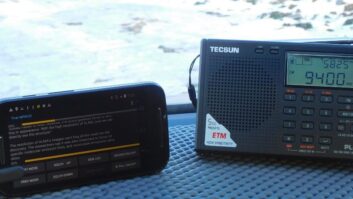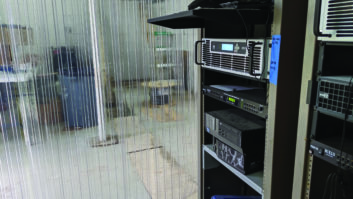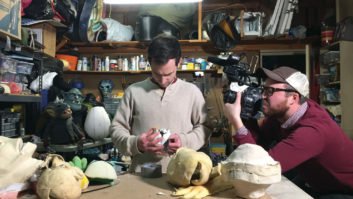
Fig. 1: A few rubber bands turn a pair of pliers into a simple third hand. Broadcast veteran Andy Butler has been using a trick, illustrated in Fig. 1, for so long that he has no idea whether he borrowed the idea from someone or just came up with the solution out of sheer desperation.
Andy writes, “This one is so simple and obvious, I’m almost ashamed to submit it.”
I’m glad Andy sent it along. I’ve never seen the idea, but it’s a great solution when you need a third hand.
Andy was using the pliers to hold the wire bundle so he could slit the shrink wrap without slicing his finger. One of his colleagues asked where he learned the trick; Andy had to admit that he really didn’t remember but sent it along so it might help somebody else.
Yes, I guess a pair of Irwin brand Vise-Grips would work, but we don’t always have those in our toolbox. So grab some rubber bands and wrap them around the handle of your pliers. That way, they’ll always be handy.
****
Larry Schropp has been providing contract technical services for broadcast stations since 1982.
He saw our writeup about the Franklin Lightning Sensor evaluation kit and wanted to pass on some additional information about these devices.
The American Radio Relay League Contest Update Newsletter recently mentioned a couple of lightning detectors used by ham radio astronomers working on the very large array antennas in New Mexico. The article mentioned the AcuRite Portable Lightning Detector (approximately $45 from www.acurite.com), which estimates distance of lightning to 25 miles, as well as counting strikes. The story also listed a model called StrikeAlert (approximately $65 and available at www.strikealert.com).
Larry decided to try the AcuRite unit, and found it to work pretty well. He has used it when he has tower climbers on a client’s site and when working in transmitter buildings during lightning season. Larry concluded that the detector is a simple, inexpensive safety item to have on hand.
Larry and his son Jim handle contract work for stations primarily in the Carolinas, but also special project work east of the Mississippi.
The ARRL is the equivalent of SBE for radio amateurs in the United States. You can find out more at www.arrl.org.
****
Project Engineer Dan Slentz, a fellow RW contributor, was installing a 60 kVA UPS system. He normally likes to use Visio or AutoCAD to prepare his “as built” drawings, but neither was available to him during this project.
Previously Dan has mentioned www.draw.io for preparing signal flows and networking diagrams. This website prepares those types of drawings well; however, draw.io isn’t a good choice for floor plans.

Fig. 2: Inspect sealed entries for shrinkage, which opens the door to pests. If someone is trying to “paper fit” equipment in a room, including transmitters or other big cabinets, Dan found that www.floorplanner.com is ideal. It comes with a ton of pre-drawn cabinets, along with measurements that can be customized to exactly match a rack mount, transmitter, power supply, etc. This is a great tool to bookmark for someone’s workbench computer.
Another nice element of floorplanner.com is that it isn’t downloaded as software, but works off the website. This makes the drawings and the software accessible anywhere you can tap into the Internet, and you don’t have to worry about any downloads hogging memory space. Thanks, Dan, for sharing such useful tools.
****
With the colder weather creeping up on us, it’s a good time to make sure passages into and out of our buildings and tuning sheds are sealed properly.
The big openings are easy to spot, but how about the smaller crevices? You may have sealed your openings, but the sealing putty can shrink, and this leaves you open for visitors.
Fig. 2 shows seal shrinkage for an air conditioning compressor line that needs to be corrected.
Oh, and note the gravel around the building perimeter. A layer of gravel over landscape fabric will discourage weeds, as well as snakes and rodents, who prefer the cover of grass or weeds.
Even though you’re positive everything is sealed properly for the season, take a look around. Just for grins.
****
Reading Workbench is like taking a college course in hands-on radio problem-solving. Contribute your ideas, help your fellow engineers and qualify for SBE recertification credit. Send tips to[email protected].
John Bisset has spent 44 years in the broadcasting industry. He handles West Coast sales for the Telos Alliance. He is SBE certified and is a past recipient of the SBE’s Educator of the Year Award.












